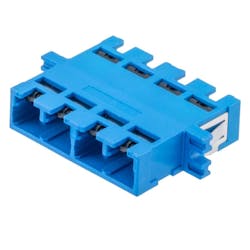SN and CS Connectors, Adapters Available from L-com
L-Com recently introduced four new products that enable network operators to increase the density of fiber connections. The company now offers the SN and CS interfaces as connectors and adapters. Senko Advanced Components developed the SN and CS connectors.
When announcing the addition of these products to its portfolio, L-Com said, “The SN adapters will allow you to fit many more connectors in a smaller space. The new CS adapters have a mechanism for sealing out contaminants and keeping your fiber lines clean and clear. The SN connectors deliver high data rates and small form factors to fit dense installations. The new CS connectors are so space-conscious that they may allow you to double the density of your patch panels.”
The SN adapters, which L-Com describes as retrofittable, are suited for cabling providers or equipment manufacturers that want to upgrade their existing systems to SN density without redesigning new panels or hardware. “Each adapter will double the density of many existing SC/LC-based hardware and thus reduce the total cost per port of the overall system,” L-Com added. “Operators can benefit from much-reduced rack consumption and improve their rack-unit revenue efficiency.” Single-channel (2 fibers), dual-channel (4 fibers), and quad-channel (8 fibers) versions are available from L-Com.
The company added that applications for these adapters include “upgrading fiber management hardware from SC/LC to SN, improving rack-space utilization in brownfield data centers, making high-density centralized crossconnects and patch panels, and combining different connector types in mixed fiber panels.”
The CS adapters have built-in, automatic shutters that prevent contamination. “With the help of a visible light source through the adapter sleeve, these devices make traceability of the adapter effortless,” L-Com claimed. These adapters are available in single-channel (2 fibers), dual-channel (4 fibers), triple-channel (6 fibers), and quad-channel (8 fibers) versions. They are often used in data centers, medical, wireless, quantum-computing, onboard optics, and fiber-to-the-home applications.
SN connectors are designed to support next-generation data rates, and allow network operators to densify their legacy infrastructure while providing an upgrade path to higher speeds such as 400G. The connectors can be terminated to 1.6-mm or 2-mm round cable with a ruggedized jacket and internal strain relief. The connector has an integrated push-pull boot that simplifies insertion and removal, particularly including in dense patch panels where finger access is limited.
The SN connector is commonly used for high-density patching; in QSFP-DD, OSFP, and SFP-DD transceiver links for high data rates; hybrid Base-2 cable assemblies that combine SN and other duplex connector types; and in hyperscale, edge, enterprise, and colocation data centers.
The CS is a very small form factor (VSFF) connector, designed for high-density data center and OSFP/QSFP-DD breakout applications. It provides a 40% size reduction compared to the LC duplex connector, which enables users to double the density of patch panels, L-Com pointed out. “They offer more room for cable management as well as better airflow within the rack,” the company added. The CS comes with a 2-mm or 3-mm boot and an integrated push-pull tab. It is UPC-polished, contains two ferrules in a single housing, and supports singlemode fiber.
“We aim to help our customers improve their fiber-optic connectivity with our new SN and CS adapters and connectors,” commented L-Com product line manager Paul Hospodar. “These product lines enable higher-density installations without the need for more space, or having to redesign panels or hardware.”
